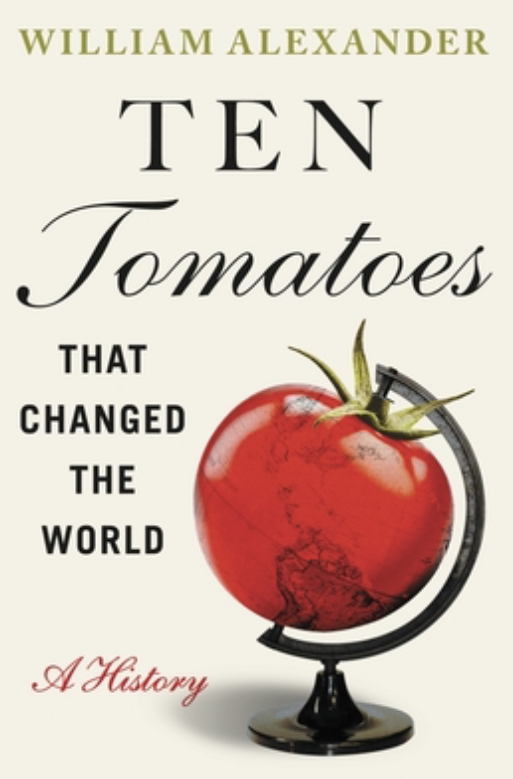Ten Tomatoes That Changed the World by William Alexander
A Book Review by Karen Kellett, Prince George MG
Generally speaking my reading choices come from the New Arrivals shelf at the Prince George Public Library and can be eclectic. When I see something that combines horticulture and history, I rarely pass it up. I recently picked up Ten Tomatoes that Changed the World by William Alexander and because surely every gardener at some time grows a tomato, I felt I had to share it with you. This book is an easy read, full of humour, insights and fascinating stories about one of our favourite foods.
In his introduction, the year is 1520 and Cortés is massacring Aztecs in order to steal their silver and gold and return it to Spain. But really, Alexander asserts, the true treasure was the tomato. The first fruits from the New World were widely varied in colour and segmented or furrowed like an acorn squash. In 1548 when the Spanish gifted some plants to Cosimo de’ Medici, whose wife was from Spain, he gave it the name pomodoro (golden fruit). Possibly misheard as pom’ amoro, in England they were known as love apples and in France as pommes d’amour. However it is from the Aztec xitomatl and Spanish tomate that we have the name we use today. It took another 200 years for the smooth, spherical tomato to arrive and another 100 years before Italians were inclined to eat them. Alexander goes on to explore the re-introduction of the tomato to North America. It first became popular commercially as bottled ketchup in the 1820s and in another ten years tomatoes were put into cans. Cans didn’t become popular until sometime later when an Englishman invented the can opener – just in time for the Civil War when preserved rations were in high demand. Small seasonal canning businesses opened by the hundreds soon after the war, often next to a farmer’s tomato field.
Other chapters are devoted to the development of the San Marzano in Italy and the origins of pizza in Naples and its spread to America. The late 19th century saw further advances in processing tomatoes and solving preservation issues. The H.J. Heinz Co. was the first to discover pectin as a natural preservative and discontinued their use of unsafe sodium benzoate. (Sodium benzoate is still found in many products today)
Returning to Italy, we discover how tomatoes met pasta (pasta al pomodoro), an interesting dive into the origins of modern Italian cuisine. Remarkably, a Mussolini supporter issued a manifesto in 1930 attempting to abolish pasta since he felt it made people weak, inactive, and sentimental when the direction the country was headed needed a fit, energetic population.
Alexander discusses the hybridization of the tomato in America beginning with simultaneous discoveries in Austria (you guessed it, Mendel) and America (Livingston) and following up with the question of who killed the flavour of grandma’s tomato. The mass produced, hard, flavourless, green-harvested Florida tomatoes appearing in stores caused a revolution among consumers. By the 1970s they had had enough and began seeking out heirloom varieties and saving seed, a ‘growing’ movement that thankfully continues to today.
In conclusion, Alexander comes to Canada and delves into the introduction of the Campari variety and the massive greenhouse production of tomatoes that began in Leamington, Ontario.
We are left with many questions. Indoor farming comes at what cost? Are thousands of acres of greenhouse crops the answer to our food security amidst climate change? How do those greenhouses contribute to those changes? Winter is coming and where will our food come from? Alexander does not have the answers to these questions other than his final act in the book – he puts the seeds of a South American tomato discovered in 1949 into a pot and six months later enjoys a BLT.
